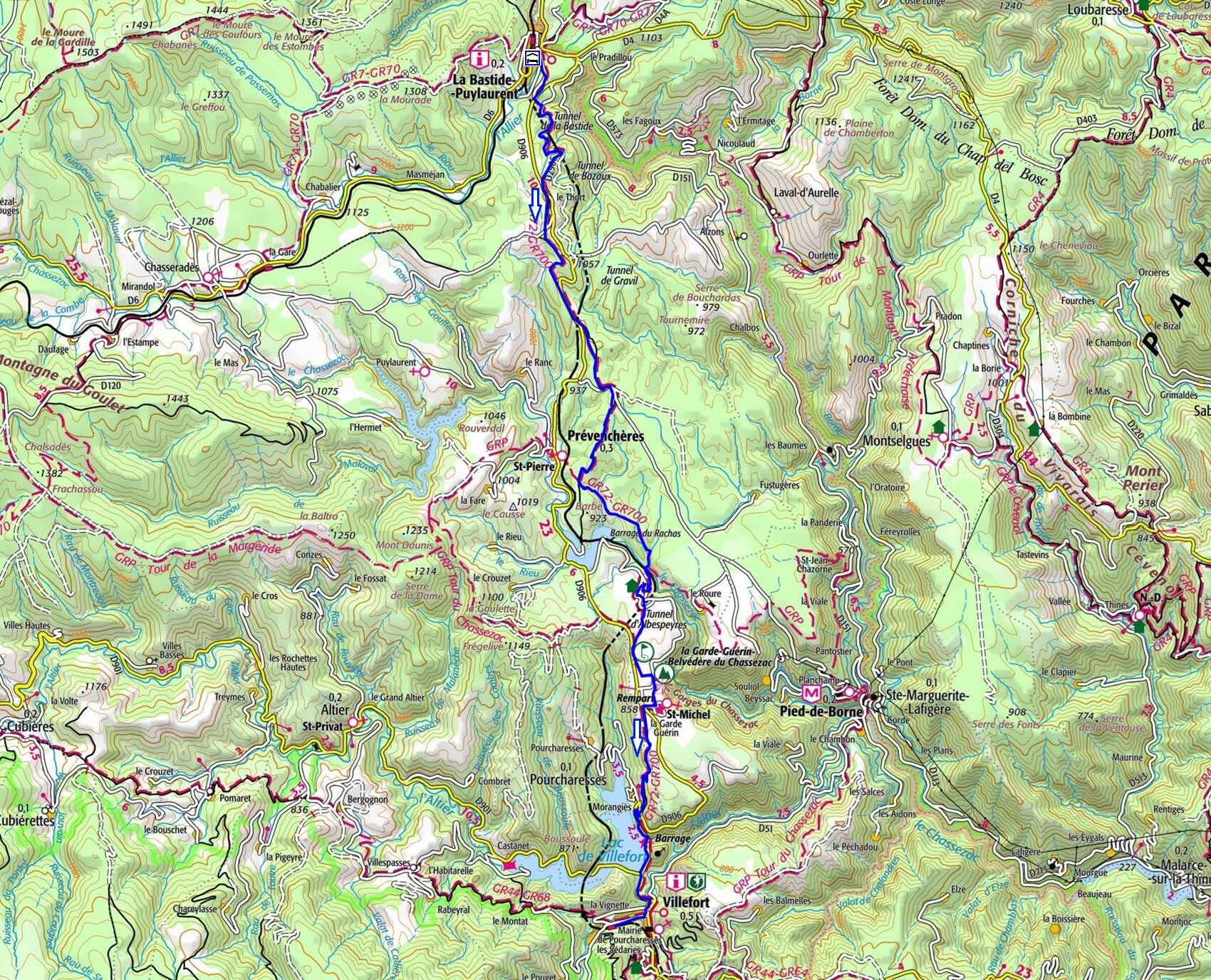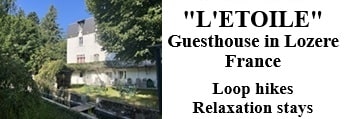      |
23,2km hike in La Bastide-Puylaurent
|
      |
Leaving the L'Etoile park through the gate, turn left and cross the Allier River via the footbridge. Proceed to the back of the church to join the GR700 Voie Regordane, which you will follow all the way to Villefort. The path passes in front of the cemetery, then crosses the D906 to rejoin the old road a little further down. Two kilometers later, turn right and ascend to the hamlet of Thort, located on the watershed divide. Then pass by the Dolmen of Thort or Palet de Gargantua, and continue straight to La Molette. After this hamlet, on the D906, the trail veers left and then right. Follow the GR700 markers to the footbridge over the Chassezac River, then pass through Albespeyres to arrive at La Garde-Guerin. The Voie Regordane then descends towards the Villefort dam. Upon arriving in the village, turn right and climb towards the train station located 700 meters further. Return by train (SNCF Timetables).

4km - 11km - 11,2km - 14km - 15,5km - 16,3km - 19km - 21,5km - 23,2km - 24km
Google Maps - Google Earth - GPX








Distance: 23.2km Maximum altitude: 1,125m Minimum altitude: 576m Total elevation gain: 386m
IGN Maps: La Bastide-Puylaurent (2738E), Mont Lozere Florac PN des Cevennes (2739OT), Largentiere La Bastide-Puylaurent Vivarais Cevenol (2838OT)
Print the hike
The Voie Regordane originated long before humans appeared, following a north-south dislocation with plate shifts that opened up passes—most notably the significant one south of Villefort, offering a low-altitude passage through a 60-kilometer-long barrier formed by Mont Lozere and the Mas de l'Aire range. This fault gave rise to numerous springs along the route.
The first animals instinctively took this path, moving from spring to spring, from pass to pass, in a spontaneous movement of transhumance. Millennia later, humans followed the animals, creating a drovers' road—a simple track. Some believe, not without reason, that tin convoys used it between the Phoenician ports of Saint-Valery-en-Caux in Normandy and Saint-Gilles. The Romans likely used it to transport metals extracted on both sides, in places dedicated to the god of commerce and industry, such as Mercoire, Mercoirol, and Mercouly.
However, it was not yet a major route as it became in the Middle Ages, after the division of the Carolingian Empire placed the Rhône Valley in the Germanic Empire, making the Regordane Way the easternmost route of the Kingdom. It was during this time (12th–13th centuries) that the transport of goods developed, thanks to advances in harnessing when it was realized that animals pull by their weight (like humans, by the way) and not—as is sometimes taught in school textbooks—due to the discovery of shoulder traction, which the Egyptians already practiced in the time of Tutankhamun, fourteen centuries before Christ.
The route was then laid out on the high plateaus of Thort, La Molette, and La Garde-Guerin, and carved into the schist on the slopes of the Ceze valleys. In the villages, houses were built over large warehouses that opened onto the main street through ogival doors, remnants of which can still be seen in Genolhac in the Gard. Small vehicles, carrying hardly more than 500 kilograms due to the materials used in their construction, traveled along this route.

Former holiday hotel with a garden along the Allier, L'Etoile Guest House is located in La Bastide-Puylaurent between Lozere, Ardeche, and the Cevennes in the mountains of Southern France. At the crossroads of GR®7, GR®70 Stevenson Path, GR®72, GR®700 Regordane Way, GR®470 Allier River springs and gorges, GRP® Cevenol, Ardechoise Mountains, Margeride. Numerous loop trails for hiking and one-day biking excursions. Ideal for a relaxing and hiking getaway.
Copyright©etoile.fr









